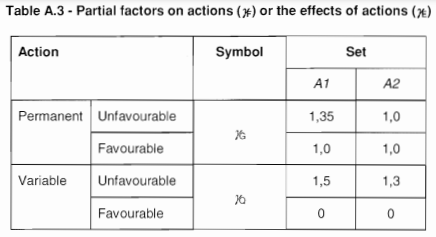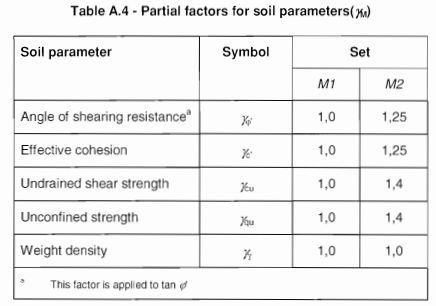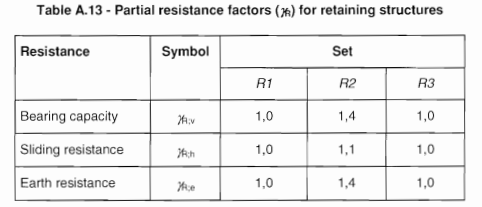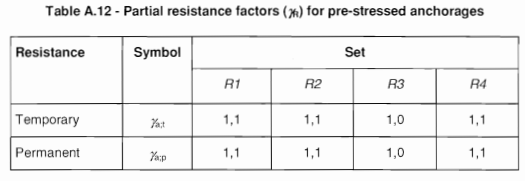APPLICATION OF THE APPROACHES PROVIDED BY EUROCODE 7
![]()
For all works except axially loaded piles and anchors:

For axially loaded piles and anchors:

![]()
![]()
![]()



Sliding check on the bedding plane

The coefficients to be used for this check are as follows:
DA1 – C1
Coefficient A1 (permanent actions): γ = 1 (favorable) or γ = 1.35 (unfavorable)
Coefficient A1 (variable actions): γ = 1 (favorable) or γ = 1.5 (unfavorable)
Coefficient M1: γ = 1 (both for cohesion and shear resistance angle)
Coefficient R1: γ = 1
DA1 – C2
Coefficient A2 (permanent actions): γ = 1 (favorable) or γ = 1 (unfavorable)
Coefficient A2 (variable actions): γ = 1 (favorable) or γ = 1.3 (unfavorable)
Coefficient M2: γ = 1.25 (both for cohesion and shear resistance angle in drained conditions) - γ = 1.4 (cohesion in undrained conditions)
Coefficient R1: γ = 1
DA2
Coefficient A1 (permanent actions): γ = 1 (favorable) or γ = 1.35 (unfavorable)
Coefficient A1 (variable actions): γ = 1 (favorable) or γ = 1.5 (unfavorable)
Coefficient M1: γ = 1 (both for cohesion and shear resistance angle)
Coefficient R2: γ = 1.1
DA3
Coefficient A2 (permanent actions): γ = 1 (favorable) or γ = 1 (unfavorable)
Coefficient A2 (variable actions): γ = 1 (favorable) or γ = 1.3 (unfavorable)
Coefficient M2: γ = 1.25 (both for cohesion and shear resistance angle in drained conditions) - γ = 1.4 (cohesion in undrained conditions)
Coefficient R3: γ = 1
Check against pull-out

The coefficients to be used for this check are:
DA1 – C1
Coefficient A1 (permanent actions): γ = 1 (favorable) or γ = 1.35 (favorable)
Coefficient A1 (variable actions): γ = 1 (favorable) or γ = 1.5 (favorable)
Coefficient M1: γ = 1 (both for cohesion and shear resistance angle)
Coefficient R1: γ = 1.1
DA1 – C2
Coefficient A2 (permanent actions): γ = 1 (favorable) or γ = 1 (favorable)
Coefficient A2 (variable actions): γ = 1 (favorable) or γ = 1.3 (favorable)
Coefficient M2: γ = 1.25 (both for cohesion and shear resistance angle in drained conditions) - γ = 1.4 (cohesion in undrained conditions)
Coefficient R4: γ = 1.1
DA2
Coefficient A1 (permanent actions): γ = 1 (favorable) or γ = 1.35 (favorable)
Coefficient A1 (variable actions): γ = 1 (favorable) or γ = 1.5 (favorable)
Coefficient M1: γ = 1 (both for cohesion and shear resistance angle)
Coefficient R2: γ = 1.1
DA3
Coefficient A1 (permanent actions): γ = 1 (favorable) or γ = 1.35 (favorable)
Coefficient A1 (variable actions): γ = 1 (favorable) or γ = 1.5 (favorable)
Coefficient M2: γ = 1.25 (both for cohesion and shear resistance angle in drained conditions) - γ = 1.4 (cohesion in undrained conditions)
Coefficient R3: γ = 1
Internal checks

The coefficients to be used for this verification are as follows:
DA1 – C1
Coefficient A1 (permanent actions): γ = 1 (favorable) or γ = 1.35 (favorable)
Coefficient A1 (variable actions): γ = 1 (favorable) or γ = 1.5 (favorable)
Coefficient M1: γ = 1 (both for cohesion and shear resistance angle)
Coefficient R1: γ = 1
DA1 – C2
Coefficient A2 (permanent actions): γ = 1 (favorable) or γ = 1 (favorable)
Coefficient A2 (variable actions): γ = 1 (favorable) or γ = 1.3 (favorable)
Coefficient M2: γ = 1.25 (both for cohesion and shear resistance angle in drained conditions) or γ = 1.4 (cohesion in undrained conditions)
Coefficient R1: γ = 1
DA2
Coefficient A1 (permanent actions): γ = 1 (favorable) or γ = 1.35 (favorable)
Coefficient A1 (variable actions): γ = 1 (favorable) or γ = 1.5 (favorable)
Coefficient M1: γ = 1 (both for cohesion and shear resistance angle)
Coefficient R2: γ = 1.1
DA3
Coefficient A2 (permanent actions): γ = 1 (favorable) or γ = 1 (favorable)
Coefficient A2 (variable actions): γ = 1 (favorable) or γ = 1.3 (favorable)
Coefficient M2: γ = 1.25 (both for cohesion and shear resistance angle in drained conditions) or γ = 1.4 (cohesion in undrained conditions)
Coefficient R3: γ = 1
Checks for nail failure
In this case, the same combinations defined for the pull-out check are used.